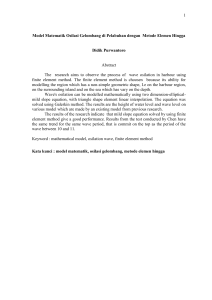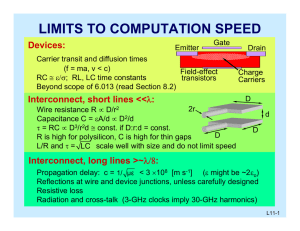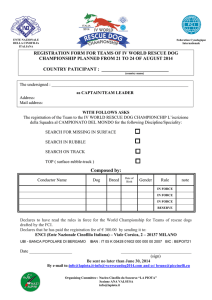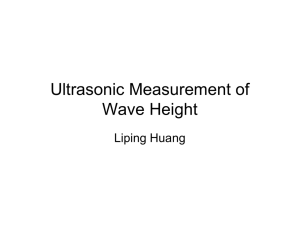2 019 D 2.019 Desiign of Ocean S Systems f O
advertisement
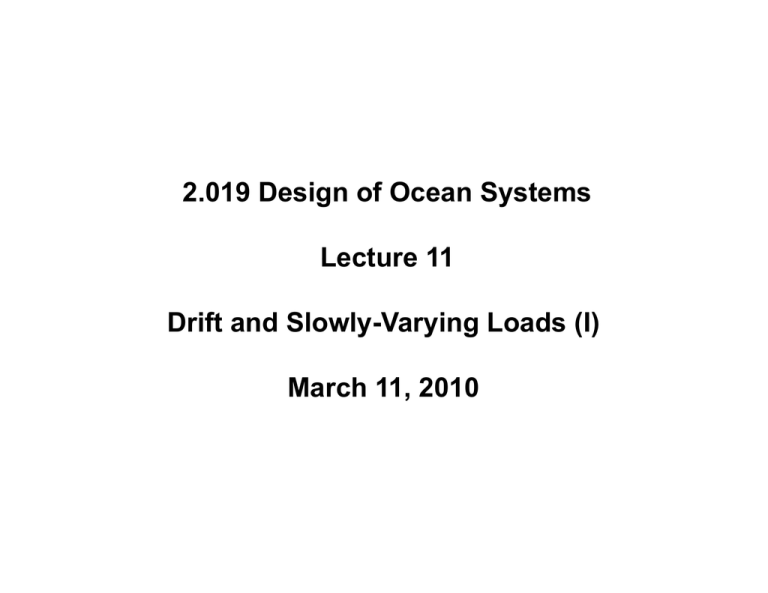
2 019 D 2.019 Desiign off O Ocean Systems t Lecture 11 Drift and Slowly y-Varying y g Loads (I) ) March 11, 2010 Drift (or Mean) Forces/Moments • Wind: Steady (and unsteady) drag forces/moments • Current: Steady drag forces/moments • Waves: Nonlinear wave loads including steady and unsteady loads Imp portant for desig gn of mooring g syystem for station keep ping g !! Wind Drag Forces/Moments Image by MIT OpenCourseWare. Fwind = 1 2 ρair Cs CH V10 |V10 |S Mwind = P Fwind × h Cs: shape coefficient (or Drag coefficient), Cs=1.0 for large flat surface CH: height coefficient, CH=1.0 for FPSO V10: wind velocity at 10m above sea surface S: Project area of the exposed surfaces in the vertical or the heeled condition h: vertical distance between center of wind force and center of resistance (by mooring lines, etc) Current Drag Forces and Moments For normal incidence, incidence Uf Fcurrent • Body is fixed: Fcurrentt = 12 ρw CD Uf |Uf |S CD: Drag coefficient Uf: Current velocity S: Project area of the exposed surfaces ρw: water density • Body moves at Ub: CD of cylinder 1.4 1.0 0.6 0.2 1/10000 Fcurrent = 12 ρw CD (Uf − Ub )|Uf − Ub |S • Frictional drag coefficient on a ship hull: Cf = 1/1000 1/100 Roughness k/D 1/10 Image by MIT OpenCourseWare. 0.075 (log10 (Rn)−2)2 Rn: Reynolds number in terms of ship length L Current Drag Forces and Moments I oblique In bli iincident, id t Uf Ft Uf β Un Ut Fn Normal component Un causes flow separation drag, tangential component Ut causes frictional drag Fn = 12 ρCD Un |Un |S Ft = 12 ρCf Ut |Ut |St Valid for β in the range of 30o to 150o. Wave Drift (Mean) Force/Moment Incident wave: z ηI = a cos(ωt − kx) y x Wave drift force/moment comes from: (1) 2nd-ord der h hyd drod dynamiic pressure due tto tth he fifirstt ord der wave (2) Interaction between the first-order motion and the first-order wave 2nd-order Hydrodynamic Mean Pressure Consider a simple plane progressive wave in deep water: −kz Φ(x z, Φ(x, z t) = gA e sin(ωt − kx) kx) ω η(x, t) = a cos(ωt − kx) We look at the pressure field of the wavefield: P (x,z,t) ρ 1 = − ∂Φ ∂t − 2 ∇Φ · ∇Φ − gz ∇Φ · ∇Φ = Φ2x + Φ2y + Φ2z n o2 gAk kz 2 Φx = − ω e cos(ωt − kx) = (ωAekz )2 cos2 (ωt − kx) n o2 gAk kz 2 Φz = sin(ω t − kx) = (ωAe (ωAekz )2 sin2 (ωt − kx) ω e ∇Φ · ∇Φ = Φ2x + Φ2z = (ωAekz )2 Steady, independent of time, and ~A2. 2nd-order mean pressure component: ρA2 (ωekz )2 Integration this mean pressure component over body surface to give mean force/moment Interaction Between Body Motion and First-Order Wave F~ (t) = R S(t) P (t)~nds = Source: Faltinsen, O. M. Sea Loads on Ships and Offshore Structures. Cambridge University Press, 1993. © Cambridge University Press. All rights reserved. This content is excluded from our Creative Commons license. For more information, see http://ocw.mit.edu/fairuse. R S0 R P (t)~nds + S0 R ∆S(t) P (t)~nds P ~nds 2nd-order mean pressure effect Direct Pressure Integration Drift D ift force f can be obtai bt ined db by di directt iinttegratition off th the pressure over th the body d surface and then taking time average: F~ (t) = R P (t)~n nds ds = S(t) R S(t) © ª −ρgz − ρ ∂∂Φt − ρ2 (Φ2x + Φ2y + Φ2z )2 ~nds = · · · · · · For example, Φ((x, z, t)) = Z 2gA kz ω e cos ωt cos kx standing wave η(x, t) = 2A sin ωt cos kx The first two terms’ terms contribution: x −ρg Rη 0 zdz − ρ ¯ ∂Φ ¯ ∂t z=0 η = ρgA2 The third term’s term s contribution: ρ − 2 Diagram showing drift forces and incident waves on a vertical wall, Z. Image by MIT OpenCourseWare. 2 The total horizontal drift force on the wall is: 1 ρgA 2 Z 0 −∞ (Φ2x + Φ2y + Φ2z )2 ds Z ρ 0 1 4g 2 A2 2 2kz k e dz =− 2 −∞ 2 ω 2 1 = − ρgA2 2 Far-Field Formula Mean force or moment on a floating body can also be obtained using the soso called far-field formula developed from the momentum theorem. Momentum theorem: z η_ η 8 8 x S_ S 8 8 Control Volume Reflected Waves Transmitted Waves y AR A AT Image by MIT OpenCourseWare. Fx = ρg 2 4 (A + A2R − A2T ) P x Fx (t) + F M = dM dt P P x Fx (t) + F M = dM dt Fx is th the force actiting on conttroll volume, FM is total momentum flux into the control volume, Mx is linear momentum in control volume dMx dt z Incident Waves P =0 Fx contains force on body, force on S-∞ and S+∞ FM contains momentum flux into control volume from boundaries S- and ∞ S+∞ Since A2 = A2R + A2T , we finally have Fx = ρg 2 2 AR •Mean force/moment is 2nd-order in wave amplitude _ F2 ρgζa2 F2 is the horizontal f force in i wave direction on the 2D body ω _ D g F2 is the horizontal force in wave direction on the 2D body; D = draught, ζa = wave amplitude of the incident waves, ω = circular frequency of oscillations. Image by MIT OpenCourseWare. Mean Force/Moment in Irregular Sea F̄j = HF̄j (ω)A2 , j = 1, . . . , 6 ¯ where HF F̄j is the transfer function for mean force Fj In irregular sea, F̄j = N X HF̄j (ωi )A2i j = 1, . . . , 6 i=1 Ai is the wave amplitude of the i-th wave component. p Ai = F̄j F = N X 2 S ( ω i ) ∆ω HF¯j (ωi )2S ((ωi )∆ω j = 1, 1 ...,6 i=1 = 2 Z 0 ∞ S (ω )HF̄¯j (ω )dω j = 1, 1 ...,6 MIT OpenCourseWare http://ocw.mit.edu 2.019 Design of Ocean Systems Spring 2011 For information about citing these materials or our Terms of Use, visit: http://ocw.mit.edu/terms.
